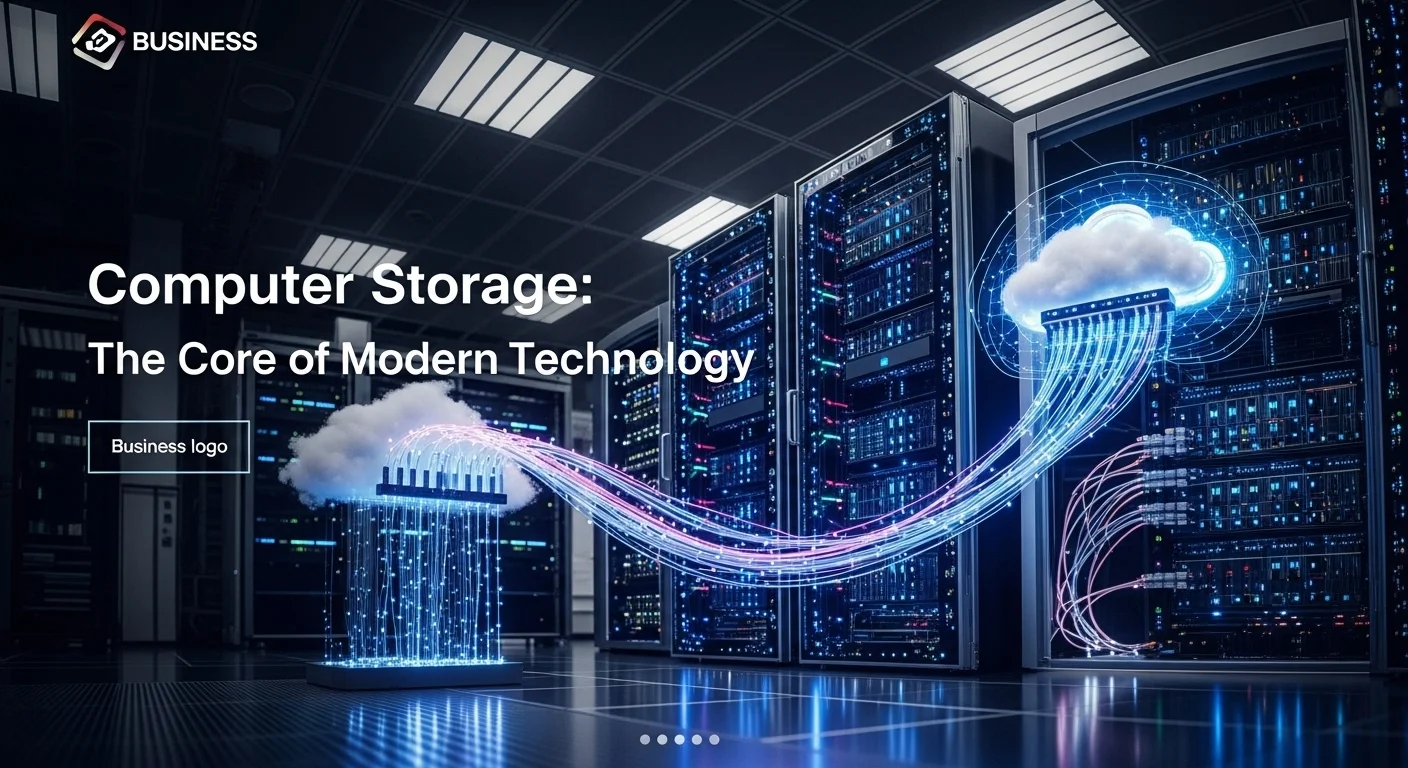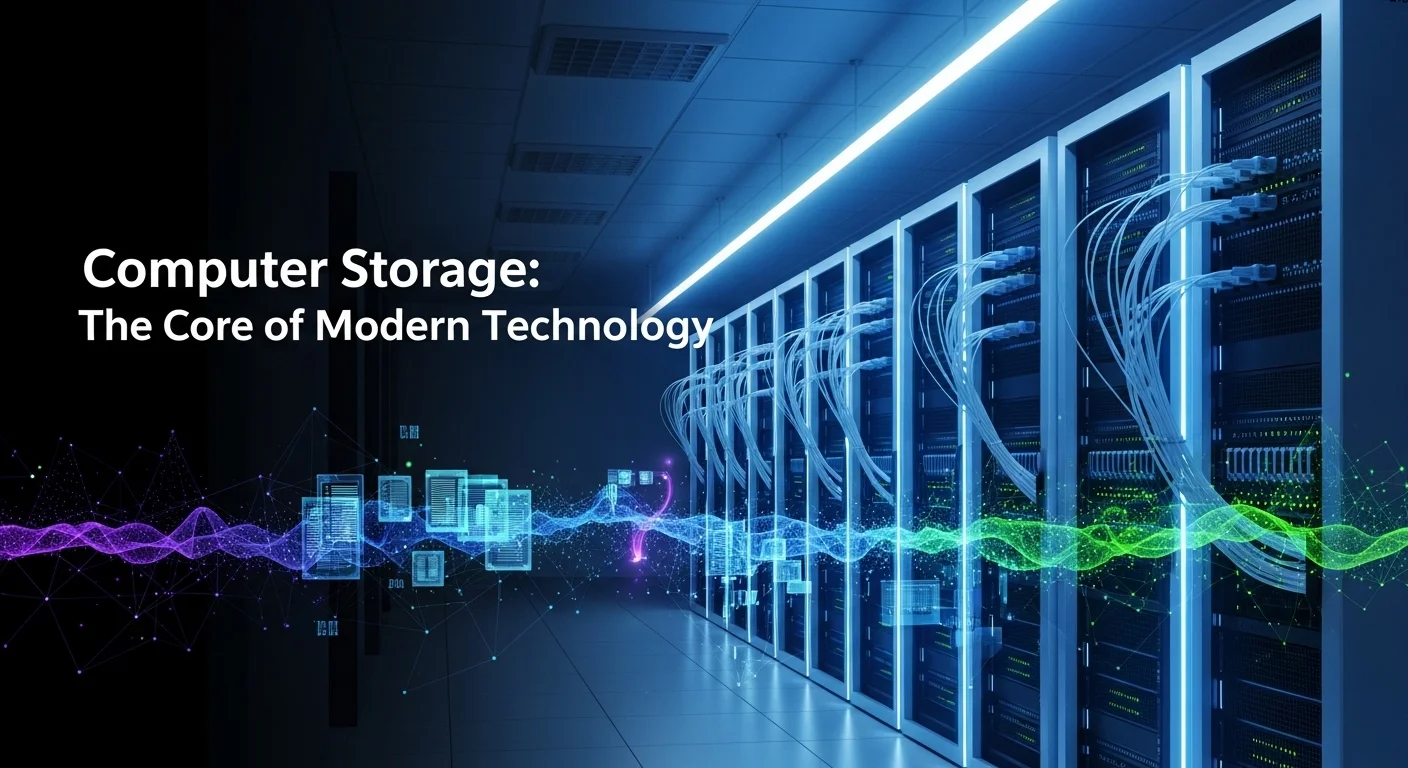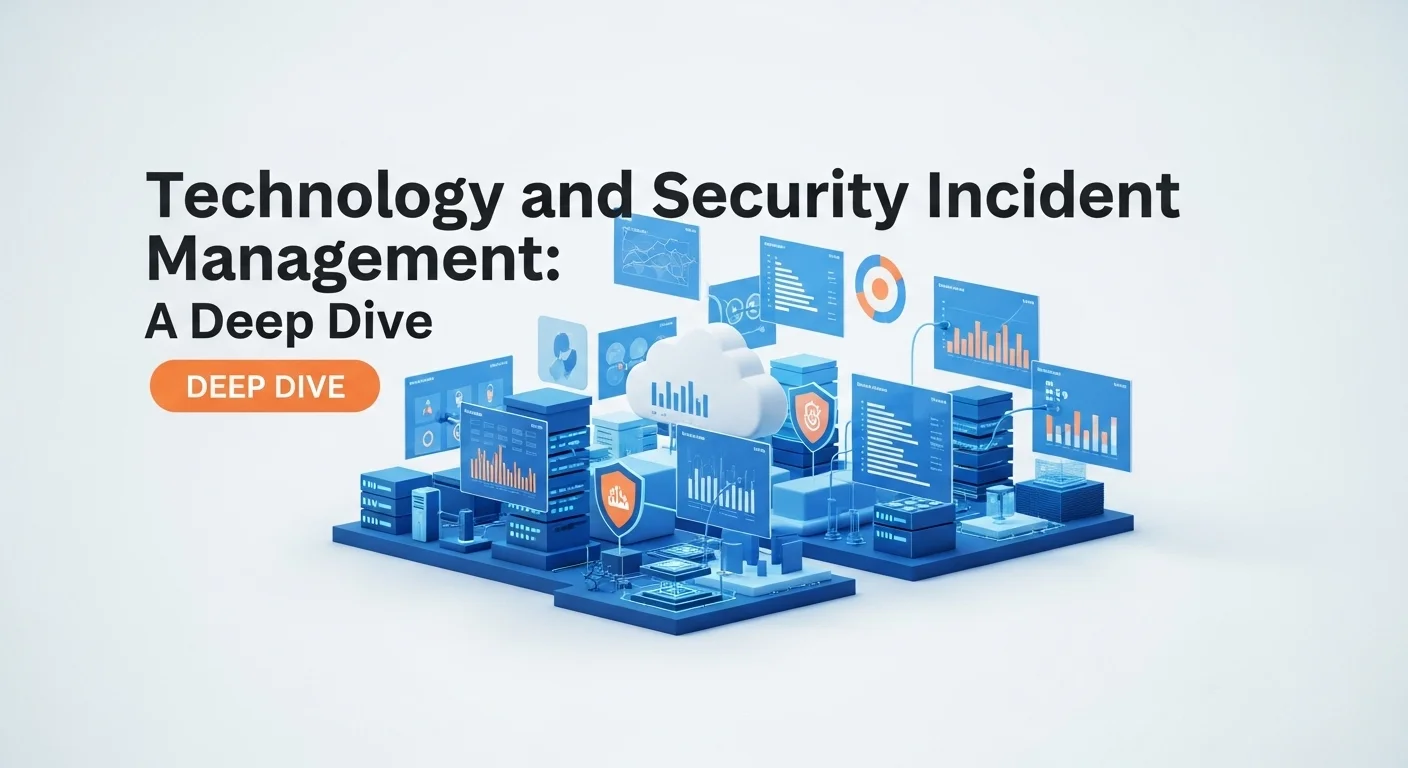Your Ultimate Guide to Computer Storage: From Hard Drives to the Cloud

Executive Summary
In our digital world, we talk about data being the 'new oil,' but what's often overlooked is the barrel that holds it: storage. I've spent years in the trenches of IT, watching storage evolve from clunky server room racks to the invisible, limitless power of the cloud technology. This article is my way of sharing that journey with you. We'll start with the basics, exploring how we got from giant, spinning disks to the tiny, lightning-fast drives in our phones. We'll then dive into the real-world solutions—from simple network drives for small businesses to the massive cloud systems that power enterprises and AI. I'll demystify cloud concepts like 'storage as a service' and explain the crucial partnership between processing power and storage. Most importantly, we'll talk about keeping your most valuable asset—your data—secure. This is for the business leader, the IT pro, or anyone curious about the unsung hero of technology.
Table of Contents
Table of Contents
- What is Computer Storage and Why Does It Matter?
- The Journey of Storage: From Punch Cards to the Cloud
- The Powerful Duo: Compute and Storage
- Why Storage is the Bedrock of Modern Business
- A Practical Guide to Storage Solutions
- On-Premises Storage: When Control is Key
- The Cloud Revolution: Ultimate Flexibility and Scale
- Protecting Your Data: A Modern Security Strategy
- Actionable Tips to Improve Your Storage Experience
- Foundational Best Practices for Everyone
- Advanced Strategies for Cloud and Hybrid Setups
- Proactive Security: Staying Ahead of Threats
- What's Next in Storage Technology?
What is Computer Storage and Why Does It Matter?
In a world buzzing about 'data,' it's easy to forget the physical reality behind it. I like to think of data as our digital memories and tools. Computer storage is simply the place where we keep them. It's the technology, made up of computer parts and recording media, that holds onto our digital information. From the family photos on your phone to the massive databases that run our global economy, storage is the fundamental building block. Without it, every time you switched off a device, everything on it—your apps, your documents, the operating system itself—would simply disappear. Its importance is profound; it’s the permanent memory of our digital lives, the foundation for every piece of software and every online experience we have.
To really get it, let's break it down into two main types. First, there's primary storage, which you probably know as RAM or memory. Think of it as your desk or workbench—it’s super fast and holds everything you're actively working on right now. But when the power goes off, the desk is cleared. It's volatile. Then you have secondary storage, which is non-volatile. This is your filing cabinet or your warehouse—it keeps your information safe even when the power is off. This includes things like hard disk drives (HDDs), solid-state drives (SSDs), and, in a bigger sense, cloud storage. The magic of modern computing happens in the seamless dance between this lightning-fast, temporary workbench and the slower, permanent warehouse.
The Journey of Storage: From Punch Cards to the Cloud
The history of computer storage is an incredible story of shrinking devices and exploding capacity. I remember working with some of the early, bulky servers, and it's mind-boggling to see how far we've come. We started with things like punch cards—stiff paper with holes—to store data. The 1950s brought magnetic tape, and in 1956, IBM unveiled the first hard drive. It was the size of two large refrigerators and held a measly 5 megabytes. Today, a microSD card smaller than my thumbnail can hold over a terabyte. That's a 200,000-fold increase in a device millions of times smaller. It's truly remarkable.
The 80s and 90s gave us floppy disks and CDs, making data portable for everyone. But the real game-changers for personal and business computing were the modern Hard Disk Drives (HDDs) and the invention of Solid-State Drives (SSDs). HDDs use spinning magnetic platters, like tiny record players, while SSDs use flash memory with no moving parts. This made them faster, tougher, and more efficient, unlocking everything from quick boot-ups to the ability to analyze huge datasets.
This entire evolution has led us to the age of the cloud. We're no longer limited by the hardware in front of us. This shift has introduced powerful new ways of thinking, especially the model of renting storage from the cloud, often called Storage as a Service (STaaS). Instead of buying and maintaining expensive hardware, companies can rent space from a provider. This turns a massive upfront investment into a manageable monthly bill and offers incredible scalability—you can grow or shrink your storage as needed, almost instantly.
The Powerful Duo: Compute and Storage
In any tech conversation, especially about the cloud, you'll hear about 'compute' and 'storage.' They are the two pillars of cloud services. 'Compute' is the brainpower (CPU and RAM) that runs your applications. 'Storage' is where the data lives. In the old days, they were stuck together in one box—a single server. If you needed more storage, you had to buy a whole new server with more compute power, whether you needed it or not. The cloud changed that by decoupling them. This means you can scale your storage capacity without touching your compute power, and vice versa. Imagine you have a massive video archive. You need tons of storage, but not much processing power just to hold the files. Decoupling lets you pay for a huge amount of cheap storage and only a small amount of compute, saving a ton of money and giving you amazing flexibility.
This flexibility is boosted by different types of cloud storage. The newest and most dominant model is object storage. Instead of organizing data in folders, object storage treats each file as a self-contained 'object' with its data, its description (metadata), and a unique ID, all held in a vast, flat space called a 'bucket.' I've seen firsthand how this architecture allows for near-infinite scaling, which is why it's perfect for unstructured data like images, videos, backups, and the massive datasets needed for Big Data and AI. Giants like AWS, Google Cloud, and Microsoft Azure have all made object storage a core part of their platforms.
Why Storage is the Bedrock of Modern Business
For any modern business, a solid storage strategy isn't just an IT issue; it's a business necessity. Data fuels everything we do—customer relationships, financial records, marketing, and operations. I've seen businesses crippled by storage failures. It can lead to catastrophic data loss, costly downtime, and a damaged reputation. It's something you have to get right.
On top of that, the rise of AI and machine learning has put even more pressure on storage systems. Training an AI model means feeding it enormous amounts of data, which needs to be stored and accessed with incredible speed and reliability. Object storage, with its massive scale, is perfectly suited for this.
Of course, as our reliance on data grows, so does the risk. Securing all this information is a massive challenge. This makes data security within cloud storage a top priority. While cloud providers build Fort Knox-level security into their data centers, protecting your data is a shared responsibility. You need to implement your own security measures, like strong encryption for data whether it's sitting on a disk (at rest) or moving across the internet (in transit), strict access controls, and regular security checks. Today, choosing a storage solution is about far more than just size and speed; it's about building a secure and resilient foundation for your entire business.

A Practical Guide to Computer Storage Solutions for Your Business
Finding your way through the world of computer storage can feel overwhelming. With so many options, from physical hardware in your office to the vastness of the cloud, how do you choose? I've helped countless businesses navigate this landscape, and the key is always to match the technology to the need. Let's break down the most common computer storage solutions so you can make a confident choice.
On-Premises Storage: When Control and Speed are Key
Before the cloud was everywhere, all storage was 'on-premises'—meaning, you owned and managed it yourself. While the cloud is fantastic, on-prem solutions are still vital, especially when you need maximum performance and absolute control over your data.
1. Direct-Attached Storage (DAS)
DAS is the most straightforward type of storage. It's a drive connected directly to a single computer or server, like the internal SSD in your laptop or an external hard drive plugged in via USB.
How it works: It's simple—the computer's operating system manages the drive directly. Because there's no network involved, data access is incredibly fast. The downside? Sharing that data with others is clunky, and you can only add as many drives as your computer has ports.
Who it's for: I've seen this work perfectly for small businesses or creative professionals, like video editors, who need blazing-fast, dedicated storage for a single workstation. It's cheap and easy but not built for teamwork.
2. Network-Attached Storage (NAS)
A NAS is like having your own private, mini-cloud right in your office. It's a dedicated device that connects to your network, allowing everyone on your team to access and share files from one central spot.
How it works: A NAS is a simple server designed for one thing: sharing files. It plugs into your office network (via Ethernet) and uses common file-sharing protocols. To your computer, it just looks like another shared drive on the network.
Who it's for: NAS devices are a lifesaver for small and medium-sized businesses. I recommend them all the time for centralizing documents, simplifying backups, and making collaboration easy. They offer a great balance of cost, convenience, and scalability for everyday file sharing.
3. Storage Area Network (SAN)
A SAN is the heavyweight champion of on-premises storage. It's a specialized, high-speed network designed specifically to connect servers to a shared pool of storage devices.
How it works: This is where things get more technical. Unlike a NAS that shares files, a SAN shares raw data 'blocks.' To the server, the SAN storage looks and acts like a local drive, which allows for incredibly high performance. This is typically achieved with high-speed connections like Fibre Channel.
Who it's for: SANs are for large enterprises with mission-critical needs. Think huge databases, complex virtualization setups (like VMware), and high-traffic e-commerce sites. They are immensely powerful and scalable but also complex and expensive to manage.
The Cloud Revolution: Ultimate Flexibility and Scale
Cloud storage has been a complete game-changer, giving everyone access to enterprise-grade infrastructure on a pay-as-you-go basis. The core idea is storage as a service (STaaS), where you rent what you need from a provider who handles all the complicated hardware and maintenance. It's been a liberating shift for so many businesses.
1. File Storage in the Cloud
Think of this as a NAS in the cloud (e.g., Amazon EFS, Azure Files). It provides a fully managed file system that your cloud servers can access. It's a great option if you want to move an existing application to the cloud without having to completely redesign how it handles files.
2. Block Storage in the Cloud
This is the cloud equivalent of a hard drive for your virtual server (e.g., Amazon EBS, Azure Disk Storage). You attach a 'volume' of block storage to your cloud server, format it, and use it just like a physical drive. A key advantage here is that you can often pay for the exact performance you need (measured in IOPS), making it a fundamental part of most cloud compute and storage services.
3. Object Storage in the Cloud: The New Standard
As I mentioned earlier, object storage has become the go-to for modern applications, and for good reason: its incredible scale, durability, and low cost are hard to beat.
How it works: Data is stored as 'objects' in a flat 'bucket.' Access is handled through web-based APIs, which makes it super flexible and easy for developers to work with. These systems are built for resilience, automatically making copies of your data across different locations to prevent loss.
Business uses I see every day:
- Backup and Archiving: Its low cost and high durability make it a no-brainer for disaster recovery and long-term data storage.
- Big Data & Data Lakes: It can hold almost limitless amounts of unstructured data, creating a 'data lake' where you can run analytics and AI models.
- Modern Web Apps: Developers use it to store everything from user-generated content to application logs.
- Distributing Content: It's often the source for Content Delivery Networks (CDNs), which deliver images and videos to users around the world quickly.
Protecting Your Data: A Modern Security Strategy
Whether your data is in your office or in the cloud, security is paramount. The cloud introduces a 'Shared Responsibility Model.' In simple terms, the cloud provider secures the physical data center, but you are responsible for securing what you put inside it. Mastering data security in the cloud comes down to a few key practices:
- Encryption is a Must: Always encrypt your data, both when it's being stored (at rest) and when it's being sent over a network (in transit). All major cloud providers make this easy.
- Control Who Has the Keys (IAM): Use Identity and Access Management (IAM) to give people and applications the absolute minimum level of access they need to do their jobs. Always use multi-factor authentication (MFA).
- Build Digital Fences: Use tools like Virtual Private Clouds (VPCs) to create isolated sections of the cloud for your resources, preventing unauthorized network access.
- Keep an Eye on Things: Constantly log and monitor who is accessing your data. This is crucial for spotting and responding to any suspicious activity.
- Stay Compliant: If you're in an industry like healthcare (HIPAA) or finance (PCI DSS), you must ensure your storage setup meets strict compliance rules. Good cloud providers offer tools and guidance to help you with this.

Actionable Tips and Strategies to Improve Your Storage Experience
In my experience, managing storage effectively goes beyond just the IT department—it's a business strategy that boosts productivity and drives success. Optimizing your storage, whether it's for your personal files or a global enterprise, boils down to a mix of smart habits, modern strategies, and using the right tools. Here are my go-to tips to help you get the most out of your computer storage, with a focus on cloud-first thinking and solid security.
Foundational Best Practices for Everyone
Before you get fancy, you have to nail the basics. These habits are universal and will save you headaches down the road, no matter what system you use.
Live by the 3-2-1 Backup Rule: This is my non-negotiable rule for data protection. It's simple: keep at least three copies of your data, store them on two different types of media, and have at least one copy off-site. For instance, have the original file on your server (copy 1), a backup on a local NAS device (copy 2, different media), and a third copy in the cloud (copy 3, off-site). This strategy protects you from nearly any disaster, from a simple hard drive failure to a fire or flood.
Practice Good Data Hygiene with Tiering: Not all data is equally important. I regularly advise clients to audit their files: what do you need instantly ('hot' data), what do you access rarely ('warm' data), and what's just for the archives ('cold' data)? This is called data tiering. It lets you move less critical data to cheaper storage. With object storage in the cloud, you can even automate this. Set up a rule to automatically move files from a standard tier to an infrequent-access tier, and then to a deep archive service like Amazon Glacier. It's a fantastic way to slash costs without lifting a finger.
Let Robots Do the Boring Work (Automation): Manual tasks are where mistakes happen. Automate things like backups, data tiering, and security checks. Using simple scripts or built-in platform features ensures critical jobs get done consistently. We're even seeing AI-powered tools emerge that can automatically optimize storage performance, which is a space I'm watching closely.
Don't Just Hope Your Backups Work—Test Them: A backup you've never tested is just a prayer. I've seen the heartbreak of a failed restore. Periodically, run a fire drill. Try to restore your data from your backup to make sure the process works. It’s the only way to find weaknesses before a real crisis hits.
Advanced Strategies for Cloud and Hybrid Setups
As you embrace the cloud, your strategy needs to mature. Treating the cloud like just another hard drive is a common mistake that leaves money and performance on the table.
Optimize Your Cloud Bill
The pay-as-you-go cloud model is great, but it can lead to surprise bills if you're not careful. The key is to use the cost management tools your provider offers, like AWS Cost Explorer or Azure Cost Management. Set up alerts to get notified if spending spikes. The biggest mistake I see is using expensive, high-performance storage for data that's rarely touched. Shifting from block or file storage to a more cost-effective cloud object storage solution for your unstructured data can lead to massive savings.
The Power of Decoupling Compute and Storage
One of the most powerful designs in modern cloud architecture is separating your processing power from your storage. Think about it: a data analytics job might need a huge amount of compute power for an hour to crunch numbers, but then that power can be shut down. The data itself remains cheaply and safely stored. This is how modern platforms like Snowflake work. By designing your applications this way, you avoid the old trap of having to scale compute and storage together, which almost always means you're overpaying for one of them.
Build a Smart Hybrid Cloud Strategy
A hybrid strategy—mixing on-premise hardware with public cloud services—often gives you the best of both worlds. You might keep a super-fast, latency-sensitive database in your own data center but use the cloud for development, backups, and disaster recovery. Tools like AWS Storage Gateway or Azure Arc create a seamless bridge between these two worlds. This approach is perfect for migrating to the cloud gradually, without a risky, all-at-once switch.
Proactive Security: Staying Ahead of Threats
In today's world of constant cyber threats, waiting for an attack to happen is not an option. A proactive approach to data security in your cloud storage is essential.
Adopt a 'Zero-Trust' Mindset: The old 'castle-and-moat' idea of security is dead. A Zero-Trust model assumes threats could be anywhere—inside or outside your network. It means you 'never trust, always verify.' In practice, this means strictly verifying every user and device, limiting access to the bare minimum needed, and segmenting your network to stop threats from spreading.
Use Immutability to Defeat Ransomware: Ransomware is a nightmare for data storage. One of the best defenses I've implemented is immutable storage, where data, once written, can't be changed or deleted for a set time. Many object storage platforms offer an 'Object Lock' feature. If you get hit by ransomware, you can just restore from your clean, unchangeable backup copies, making the attack useless.
Continuously Monitor Your Security Posture: The cloud is always changing. New resources pop up and down, creating potential security holes. Use Cloud Security Posture Management (CSPM) tools to constantly scan your setup for mistakes like public storage buckets or overly permissive access roles. These tools find and help you fix problems in real-time.
What's Next in Storage Technology?
Innovation in storage never stops. It's worth keeping an eye on what's coming. Mind-blowing technologies like DNA storage and 5D optical storage promise unbelievable density and lifespan, though they're still in the lab. More immediately, computational storage—drives that can actually process data themselves—will cut down on data movement and speed up analytics. For anyone who wants to go deeper, I highly recommend checking out the whitepapers from the Storage Networking Industry Association (SNIA) to stay on top of these trends.
By combining these foundational practices with forward-thinking cloud strategies, you can turn your computer storage solutions from a simple utility into a true competitive advantage.
Expert Reviews & Testimonials
Sarah Johnson, Business Owner ⭐⭐⭐⭐
This was really helpful! As a small business owner, the section on NAS vs. cloud storage finally made sense. I would have loved a quick cost comparison chart, but otherwise, great info.
Mike Chen, IT Consultant ⭐⭐⭐⭐
A solid overview of computer storage. It connected a lot of dots for me, especially the part about decoupling compute and storage. It's a great piece to share with clients who need to understand the 'why' behind our recommendations.
Emma Davis, Tech Expert ⭐⭐⭐⭐⭐
Fantastic article! As someone deep in the tech world, I appreciated the accurate and clear breakdown of complex topics like SANs and object storage. This is comprehensive without being overly technical. I've already shared it with my team.



